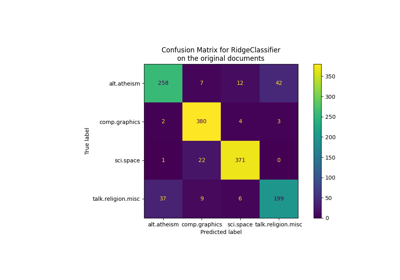Note
Go to the end to download the full example code. or to run this example in your browser via Binder
使用谱协同聚类算法对文档进行双聚类#
本示例演示了在二十新闻组数据集上使用谱协同聚类算法。排除了’comp.os.ms-windows.misc’类别,因为它包含许多仅包含数据的帖子。
TF-IDF向量化后的帖子形成一个词频矩阵,然后使用Dhillon的谱协同聚类算法进行双聚类。由此产生的文档-词双聚类指示了在这些子集文档中更常用的子集词。
对于一些最好的双聚类,打印其最常见的文档类别及其十个最重要的词。最好的双聚类是根据其归一化割确定的。最好的词是通过比较其在双聚类内部和外部的总和确定的。
作为比较,文档也使用MiniBatchKMeans进行聚类。从双聚类中得出的文档聚类比MiniBatchKMeans找到的聚类实现了更好的V-measure。
Vectorizing...
Coclustering...
Done in 1.49s. V-measure: 0.4415
MiniBatchKMeans...
Done in 1.07s. V-measure: 0.3015
Best biclusters:
----------------
bicluster 0 : 8 documents, 6 words
categories : 100% talk.politics.mideast
words : cosmo, angmar, alfalfa, alphalpha, proline, benson
bicluster 1 : 1948 documents, 4325 words
categories : 23% talk.politics.guns, 18% talk.politics.misc, 17% sci.med
words : gun, guns, geb, banks, gordon, clinton, pitt, cdt, surrender, veal
bicluster 2 : 1259 documents, 3534 words
categories : 27% soc.religion.christian, 25% talk.politics.mideast, 25% alt.atheism
words : god, jesus, christians, kent, sin, objective, belief, christ, faith, moral
bicluster 3 : 775 documents, 1623 words
categories : 30% comp.windows.x, 25% comp.sys.ibm.pc.hardware, 20% comp.graphics
words : scsi, nada, ide, vga, esdi, isa, kth, s3, vlb, bmug
bicluster 4 : 2180 documents, 2802 words
categories : 18% comp.sys.mac.hardware, 16% sci.electronics, 16% comp.sys.ibm.pc.hardware
words : voltage, shipping, circuit, receiver, processing, scope, mpce, analog, kolstad, umass
import operator
from collections import defaultdict
from time import time
import numpy as np
from sklearn.cluster import MiniBatchKMeans, SpectralCoclustering
from sklearn.datasets import fetch_20newsgroups
from sklearn.feature_extraction.text import TfidfVectorizer
from sklearn.metrics.cluster import v_measure_score
def number_normalizer(tokens):
"""映射所有数字标记到一个占位符。
对于许多应用,以数字开头的标记并不直接有用,但这种标记的存在可能是相关的。通过应用这种形式的维度降低,一些方法可能会表现得更好。
"""
return ("#NUMBER" if token[0].isdigit() else token for token in tokens)
class NumberNormalizingVectorizer(TfidfVectorizer):
def build_tokenizer(self):
tokenize = super().build_tokenizer()
return lambda doc: list(number_normalizer(tokenize(doc)))
# exclude 'comp.os.ms-windows.misc'
categories = [
"alt.atheism",
"comp.graphics",
"comp.sys.ibm.pc.hardware",
"comp.sys.mac.hardware",
"comp.windows.x",
"misc.forsale",
"rec.autos",
"rec.motorcycles",
"rec.sport.baseball",
"rec.sport.hockey",
"sci.crypt",
"sci.electronics",
"sci.med",
"sci.space",
"soc.religion.christian",
"talk.politics.guns",
"talk.politics.mideast",
"talk.politics.misc",
"talk.religion.misc",
]
newsgroups = fetch_20newsgroups(categories=categories)
y_true = newsgroups.target
vectorizer = NumberNormalizingVectorizer(stop_words="english", min_df=5)
cocluster = SpectralCoclustering(
n_clusters=len(categories), svd_method="arpack", random_state=0
)
kmeans = MiniBatchKMeans(
n_clusters=len(categories), batch_size=20000, random_state=0, n_init=3
)
print("Vectorizing...")
X = vectorizer.fit_transform(newsgroups.data)
print("Coclustering...")
start_time = time()
cocluster.fit(X)
y_cocluster = cocluster.row_labels_
print(
"Done in {:.2f}s. V-measure: {:.4f}".format(
time() - start_time, v_measure_score(y_cocluster, y_true)
)
)
print("MiniBatchKMeans...")
start_time = time()
y_kmeans = kmeans.fit_predict(X)
print(
"Done in {:.2f}s. V-measure: {:.4f}".format(
time() - start_time, v_measure_score(y_kmeans, y_true)
)
)
feature_names = vectorizer.get_feature_names_out()
document_names = list(newsgroups.target_names[i] for i in newsgroups.target)
def bicluster_ncut(i):
rows, cols = cocluster.get_indices(i)
if not (np.any(rows) and np.any(cols)):
import sys
return sys.float_info.max
row_complement = np.nonzero(np.logical_not(cocluster.rows_[i]))[0]
col_complement = np.nonzero(np.logical_not(cocluster.columns_[i]))[0]
# 注意:以下内容与X[rows[:, np.newaxis],相同
# cols].sum() but much faster in scipy <= 0.16
weight = X[rows][:, cols].sum()
cut = X[row_complement][:, cols].sum() + X[rows][:, col_complement].sum()
return cut / weight
def most_common(d):
"""defaultdict(int)中值最高的项。
类似于Python >=2.7中的Counter.most_common。
"""
return sorted(d.items(), key=operator.itemgetter(1), reverse=True)
bicluster_ncuts = list(bicluster_ncut(i) for i in range(len(newsgroups.target_names)))
best_idx = np.argsort(bicluster_ncuts)[:5]
print()
print("Best biclusters:")
print("----------------")
for idx, cluster in enumerate(best_idx):
n_rows, n_cols = cocluster.get_shape(cluster)
cluster_docs, cluster_words = cocluster.get_indices(cluster)
if not len(cluster_docs) or not len(cluster_words):
continue
# categories
counter = defaultdict(int)
for i in cluster_docs:
counter[document_names[i]] += 1
cat_string = ", ".join(
"{:.0f}% {}".format(float(c) / n_rows * 100, name)
for name, c in most_common(counter)[:3]
)
# words
out_of_cluster_docs = cocluster.row_labels_ != cluster
out_of_cluster_docs = np.where(out_of_cluster_docs)[0]
word_col = X[:, cluster_words]
word_scores = np.array(
word_col[cluster_docs, :].sum(axis=0)
- word_col[out_of_cluster_docs, :].sum(axis=0)
)
word_scores = word_scores.ravel()
important_words = list(
feature_names[cluster_words[i]] for i in word_scores.argsort()[:-11:-1]
)
print("bicluster {} : {} documents, {} words".format(idx, n_rows, n_cols))
print("categories : {}".format(cat_string))
print("words : {}\n".format(", ".join(important_words)))
Total running time of the script: (0 minutes 4.139 seconds)
Related examples




